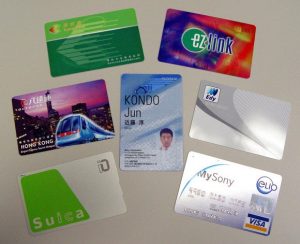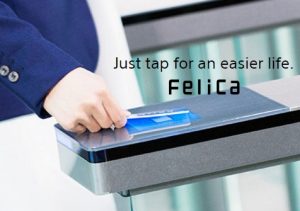Latest news about Bitcoin and all cryptocurrencies. Your daily crypto news habit.

Sony’s Felica technology is behind many of the most popular contactless NFC smart cards. Already the de facto standard in Japan for commuter travel payments, Felica is being used at the point of sale, railway and air ticketing, as well as for University ID cards – to name a few. It was recently announced that bitcoin has been successfully integrated with Felica technology. Plans have been announced for each contactless smart card to include a bitcoin wallet that holds a private key on the card.
Also read: Bitcoin to Be Accepted at 260,000 Stores in Japan by This Summer
Size of Felica’s User Base
 An example of cards using Felica technology. (Photo\ PC World)
An example of cards using Felica technology. (Photo\ PC World)
Japanese electronics and entertainment megacorp Sony Corporation originally developed Felica contactless RFID-based smart card technology. In 2007, a company called Felica Pocket Marketing Inc. was founded to sell, promote and distribute Felica contactless cards as well as leasing card terminals to member companies.
Built into smart cards, smartphones, and other devices, Felica technology is behind many of Asia’s mass transit systems and can be used as e-money, e-ID, e-tickets, and membership cards. For example, the technology is in use by both of Japan’s largest airlines, All Nippon Airways (ANA) for its Skip Service, and competitor Japan Airlines (JAL) for its Touch and Go service. It is also used in ID cards at more than 365 universities in the United States.
In 2016, Nikkei Asian Review reported that the global shipments of Felica chips were expected to top 1 billion that year.
Bitcoin Wallets Successfully Tested with Felica Technology
 Last week, Felica Marketing announced that it has developed and successfully tested a near-instant, “tap-to-pay” method for using cryptocurrencies with their contactless technology. Their tests focused on the technology’s usability, safety, and prevention of double spending.
Last week, Felica Marketing announced that it has developed and successfully tested a near-instant, “tap-to-pay” method for using cryptocurrencies with their contactless technology. Their tests focused on the technology’s usability, safety, and prevention of double spending.
At the conclusion, the company reported that the tests were successful and that bitcoin integration made for a safe and practical payment system. Additionally, the company claims to be able to produce a product that can process a bitcoin payment very quickly, similar to their current tap-to-pay options.
How Felica Bitcoin Hardware Wallets Work
 The company plans to add bitcoin hardware wallet functionality to each Felica card by adding a second memory storage chip to it.
The company plans to add bitcoin hardware wallet functionality to each Felica card by adding a second memory storage chip to it.
The existing memory chip is a “non-private memory region” that will continue to hold addresses and other information meant to be shared. Meanwhile, the new “private memory region”, called the Felica Pocket Region, was created to store the private key of a bitcoin wallet. It also makes signing each transaction more secure by isolating the private key and signature logic in tamper-resistant area.
The wallet’s private key is accessed with a tap of the card onto a reader to sign each Bitcoin transaction, according to the company. In effect, future Felica-enabled cards and devices could be used as convenient hardware wallets like the Ledger, Trezor, and Keepkey.
Bitcoin Testing Results and Limitations
 The biggest challenge integrating bitcoin to their cards was security, Felica Marketing revealed. Since the private key will be given to the payment applications, the payment apps and their providers need to be verified, although the company did not say how.
The biggest challenge integrating bitcoin to their cards was security, Felica Marketing revealed. Since the private key will be given to the payment applications, the payment apps and their providers need to be verified, although the company did not say how.
The wait time for network confirmations recommended for securing bitcoin payments is the biggest issue for retail stores when accepting bitcoin, according to Felica. Asking customers to wait in the store for multiple network confirmations has long been a problem for Bitcoin merchant acceptance. The company, therefore, uses a centralized system to confirm all transaction before broadcasting them. The end result is a centralized payment layer on top of a decentralized settlement system, which offers Felica users an instant payment in bitcoin.
The Next Step
Felica Marketing reported that the test proved that cryptocurrency payments work well with their tap-to-pay feature, while preventing double spending. Security considerations are the company’s top priority to be improved upon, specifically how to best secure the private keys, the company conveyed.
Without giving a specific date, the company announced their plans to launch multiple hardware wallets with their partner companies. They also plan to offer support services for retailers accepting bitcoin payments using Felica.
What do you think about Felica hardware bitcoin wallets? Let us know in the comments section below.
Images courtesy of Shutterstock, PC World, Sony, Felica Marketing; Translation by Bitcoin.com
Need to calculate your bitcoin holdings? Check our tools section.
The post Most Popular Contactless Smart Cards in Japan Adding Bitcoin Hardware Wallets appeared first on Bitcoin News.
Disclaimer
The views and opinions expressed in this article are solely those of the authors and do not reflect the views of Bitcoin Insider. Every investment and trading move involves risk - this is especially true for cryptocurrencies given their volatility. We strongly advise our readers to conduct their own research when making a decision.